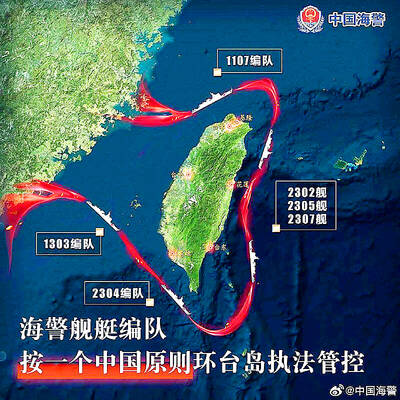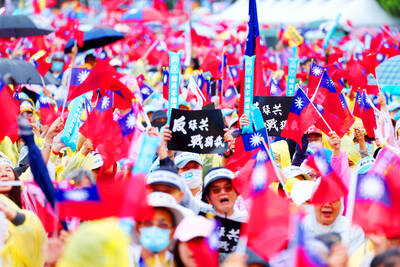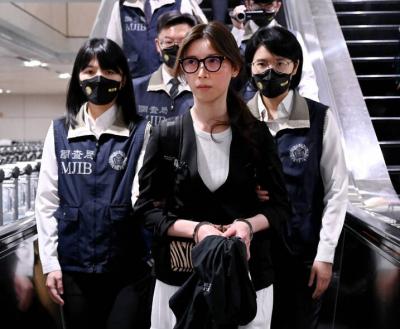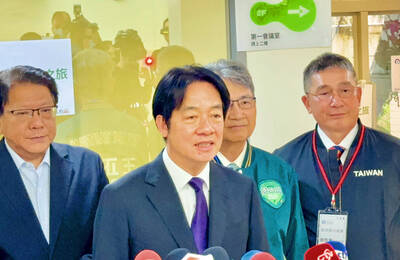Earlier this month, the Ministry of National Defense announced plans to cut troop levels by 9,200 in light of “warmer” ties with China, saying the measure would not jeopardize national defense because Taiwan was seeking “more advanced” and “high-tech” weapons.
However, with five consecutive years of shrinking defense budgets, more than US$13 billion in arms purchases still in the pipeline, a modernizing Chinese military and a US administration that appears increasingly reluctant to provide Taiwan with the weapons it needs, is the ministry’s optimism realistic or merely a smokescreen?
When asked to comment on the state of Taiwan’s defenses and how the nation could do more with a limited budget, in several instances, several defense experts made the case against high-profile expensive platforms in favor of smaller, relatively inexpensive and in many cases domestically produced asymmetrical options.
“Taiwan is on a peacetime footing budget-wise, even as its strategic plight worsens,” said James Holmes, associate professor of strategy at the US Naval War College and co-author of Red Star Over the Pacific.
“Three percent of GDP is not a serious budget for a nation facing mortal peril,” Holmes said of the goal set by President Ma Ying-jeou (馬英九), which has not been reached as the level of spending has dropped since Ma came into office in 2008, settling at about 2.2 percent of GDP for the current financial year.
In Holmes’ view, the Ma administration is allowing numbers to drive strategy and determined structure.
“The notion of substituting technology for large numbers of bodies is a seductive one, but is Taipei just trying to justify predetermined budget cuts or has it developed a strategy of island defense that can be executed with far fewer troops?” he asked.
“It sounds like the former,” Holmes said.
Normandy, France, or Okinawa, Japan, should be the frame of reference for Taiwan’s defense strategy, he said, with a future war -representing nothing less than a battle for national survival.
“Even assuming the US authorizes sales of the items Taipei wants, the present, meager defense budget would rule out purchases of high-tech arms in adequate numbers,” he said.
For Wendell Minnick, Asia bureau chief at Defense News, the ministry’s rhetoric was yet another attempt to demonstrate calm to the Taiwanse public that is increasingly concerned about continued threats from China.
“Its solution to a reduction in manpower is magic swords to slay the dragon, [but] every US military commander knows that training, maintenance and logistics win wars,” he said.
“It helps to have a magic bullet or two, but it also helps to keep the gun that fires it clean and operational,” he said.
“Taiwan’s military budget is being squeezed as defense budgets decline and costs rise with the recent acquisition of about US$13 billion worth of new arms in the pipeline. The streamlining and reorganization plan is now delayed for the next three years due to this issue,” Minnick said. “Training will be reduced as will the move from conscription to an all-volunteer force.”
Ma promised during his electoral campaign in 2008 that he would seek to create an all--volunteer military by 2014, a very expensive endeavor by any measure.
Patriot PAC-3 missile systems, P-3C Orion aircraft, early-warning radar, F-16C/Ds and submarines are among the items that are believed to be part of the ministry’s high-tech shopping list. Several of those platforms were first offered by former US president George W. Bush’s administration nearly a decade ago and may no longer reflect the scope of the military threat that China represents today, as the US-Taiwan Business Council noted in a report recently.
“To make matters worse, Taiwan’s military has a throw-away attitude with arms. It has delayed refits or upgrades for the F-16A/Bs, LaFayette frigates and Dutch-built submarines for many years,” Minnick said. “It’s hard to justify new arms deals when you ignore maintenance.”
“But then again, it’s all about the symbology of new arms from the US,” rather than actual needs, he said.
Aside from F-16C/Ds, for which the Ma administration has made repeated requests, PAC-3 and submarines, other high-tech weapons Taiwan could seek to acquire include a land or sea-based system equivalent of the Aegis combat system and SLAMRAAM, a surface-launched version of the Advanced Medium-Range Air-to-Air Missile fire-and-forget air-to-air missile the US has already sold to Taiwan.
Most analysts seemed to agree that rather than aim for highly symbolic platforms, such as F-16C/Ds, Taiwan ought to focus more on less expensive, though by no means less effective, weapons to counter an attack.
Roger Cliff, an independent defense researcher, said expensive platforms such as F-16C/Ds and US$1 billion submarines were probably not good choices.
“Taiwan should take advantage of the fact that it is an island and only needs the ability to defend itself from attack, not the ability to invade and conquer an adversary, in making decisions about what types of military capabilities to develop,” he said.
Many such systems, Cliff said, would be relatively inexpensive.
“I won’t criticize the decision to acquire the PAC-3 system, since the decision has already been made and it is probably useful to introduce some uncertainty into Chinese ballistic missile target planning,” Cliff said of the expensive air defense system. “However, I would not commit additional money to active missile defenses [and] instead would direct any additional missile defense funds toward passive defenses — fortification, hardening and dispersal.”
For defense against an -amphibious attack, Cliff said, Taiwan should invest in rapidly deployable sea mines, small unmanned aerial vehicles (UAV) for finding and targeting an invading fleet and truck-mobile and helicopter-borne radar to perform similar functions. Precision anti-armor howitzer rounds like the US Copperhead would be desirable, as would large numbers of man-portable mounted anti-armor weapons, such as the US-made Javelin. Furthermore, given Taiwan’s difficult topography, such systems would negate slower Chinese armor and would be more cost-effective than investing in expensive main battle tanks,” Cliff said.
“These systems, all of which could be acquired in large numbers at relatively low cost, would make an attack on or invasion of Taiwan an extremely daunting prospect for China,” he said.
Facing tight budgetary constraints and procurement options that for the foreseeable future would continue to be largely limited to the US, the experts were also of the opinion that Taiwan should dedicate more resources to asymmetrical and indigenous programs.
For many, ballistic and cruise missiles are key, as would be surveillance platforms and other asymmetric capabilities.
“There is a plausible way for the Ma administration to square the contradiction of declining defense budgets and personnel with the purchase of ostensibly more expensive high-tech weapons: buying [or developing] more ballistic and cruise missiles,” said Rick Fisher, a senior fellow at the International Assessment and Strategy Center in Washington.
Two Taiwanese-designed missiles that could achieve that goal, Fisher said, are the Hsiung Feng IIE cruise missile and Hsiung Feng III (HF-3) ramjet-powered anti-ship missile. Echoing Fisher, Cliff also recommended that those missiles be mounted on trucks and fast attack boats.
Although in its second term the Bush administration denied Taiwan access to certain parts required in the development of those missiles, Fisher said he did not see such constraints as posing too formidable a challenge to Taiwan. In fact, Deputy Minister of National Defense Chao Shih-chang (趙世璋) told the legislature in December last year that Taiwan was now mass-producing cruise missiles and that problems with key parts and components that had previously stalled manufacturing had been tackled.
“The HF-3 is especially useful as it can threaten China’s invasion-centric strategy,” Fisher said. “If the People’s Liberation Army [PLA] cannot guarantee a successful invasion, then [it] is much less likely to opt for an attack.”
To counter possible Chinese countermeasures, such as field laser and rail-gun weapons, Fisher said Taiwan should increase the number of missile warheads aimed at invading forces. One option would be a multiple-version of the Army Tactical Missile System (ATACMS) short-range ballistic missile developed by Lockheed Martin. One version can carry up to nine independently targeted warheads, which, added to its high maneuverability, makes it ideal for damaging large amphibious ships or destroying smaller ones, he said.
“For the price of 66 F-16C/D fighters, Taiwan could opt to purchase nearly 1,000 ATACMS,” Fisher said.
For the moment, this option would likely be off the table, as the US Department of State refuses to sell Taiwan “offensive” weapons, including ballistic missiles and certain components. Without presidential direction, Fisher said he saw no prospect of this policy changing anytime soon.
“This is the most inexpensive and least personnel intensive way to keep the PLA at bay,” he said.
For retired US commander William Murray, associate research professor at the US Naval War College and the proponent of the controversial “porcupine defense” strategy, Taiwan’s countermeasures need not necessarily be high-tech.
Decoys that could “seduce” -China’s limited numbers of -precision-guided munitions could play a substantial role in helping Taiwan survive an initial bombardment, he said. Taiwan would also benefit from a large inventory of mobile, land or fast sea-based anti-ship cruise missiles receiving targeting information from surveillance platforms, such as helicopters and UAVs, a concept supported by Cliff.
Slightly more high-tech would be laser-guided rockets or artillery rounds, which could be effective in keeping an invading force at a distance, Murray said, though he admitted that their employment would probably require an airborne-designator, which would have to operate in an environment saturated with Chinese countermeasures, such as surface-to-air missiles and anti-aircraft artillery.
Murray also pointed to the need for a survivable integrated air defense system, which should emphasize mobility and enough lethality to prevent the PLA fixed-wing tactical aircraft from delivering precision-guided munitions against critical targets in Taiwan. As such, any future acquisition of surface-to-air missiles should be truck-mounted and accompanied by a number of high-fidelity decoys, he said.
“[Those systems] are purely defensive in nature. They are relatively affordable in large numbers [and] they are more useful during a military conflict than are a handful of big-ticket items like F-16s and submarines or large surface warships,” Murray said.
“They are lethal and survivable,” he said, attributes that “would help reinforce the deterrence that kept the Taiwan Strait relatively peaceful.”
Presenting a credible, affordable and realistic deterrent would not necessarily involve headline-making weapons systems. What is more certain is that credible deterrence could be key to peace with China, not detrimental to it.
“Let’s recall the words of the strategist Al Capone: You get better results with a kind word and a gun than with a kind word alone,” Holmes said.
Note: The views expressed by the experts interviewed for this article are theirs alone and do not necessarily reflect the views of the US government.

Taiwan would benefit from more integrated military strategies and deployments if the US and its allies treat the East China Sea, the Taiwan Strait and the South China Sea as a “single theater of operations,” a Taiwanese military expert said yesterday. Shen Ming-shih (沈明室), a researcher at the Institute for National Defense and Security Research, said he made the assessment after two Japanese military experts warned of emerging threats from China based on a drill conducted this month by the Chinese People’s Liberation Army’s (PLA) Eastern Theater Command. Japan Institute for National Fundamentals researcher Maki Nakagawa said the drill differed from the

‘WORSE THAN COMMUNISTS’: President William Lai has cracked down on his political enemies and has attempted to exterminate all opposition forces, the chairman said The legislature would motion for a presidential recall after May 20, Chinese Nationalist Party (KMT) Chairman Eric Chu (朱立倫) said yesterday at a protest themed “against green communists and dictatorship” in Taipei. Taiwan is supposed to be a peaceful homeland where people are united, but President William Lai (賴清德) has been polarizing and tearing apart society since his inauguration, Chu said. Lai must show his commitment to his job, otherwise a referendum could be initiated to recall him, he said. Democracy means the rule of the people, not the rule of the Democratic Progressive Party (DPP), but Lai has failed to fulfill his

A fugitive in a suspected cosmetic surgery fraud case today returned to Taiwan from Canada, after being wanted for six years. Internet celebrity Su Chen-tuan (蘇陳端), known as Lady Nai Nai (貴婦奈奈), and her former boyfriend, plastic surgeon Paul Huang (黃博健), allegedly defrauded clients and friends of about NT$1 billion (US$30.66 million). Su was put on a wanted list in 2019 when she lived in Toronto, Canada, after failing to respond to subpoenas and arrest warrants from the Taipei District Prosecutors’ Office. Su arrived at Taiwan Taoyuan International Airport at 5am today on an EVA Air flight accompanied by a

A rally held by opposition parties yesterday demonstrates that Taiwan is a democratic country, President William Lai (賴清德) said yesterday, adding that if opposition parties really want to fight dictatorship, they should fight it on Tiananmen Square in Beijing. The Chinese Nationalist Party (KMT) held a protest with the theme “against green communists and dictatorship,” and was joined by the Taiwan People’s Party. Lai said the opposition parties are against what they called the “green communists,” but do not fight against the “Chinese communists,” adding that if they really want to fight dictatorship, they should go to the right place and face